Hands On with the Final NVIDIA Shield Hardware, Update: Now with Video
by Brian Klug on June 11, 2013 2:20 AM EST- Posted in
- Smartphones
- Android
- Mobile
- Tablets
- Android 4.2
- Shield
- Tegra 4
- NVIDIA
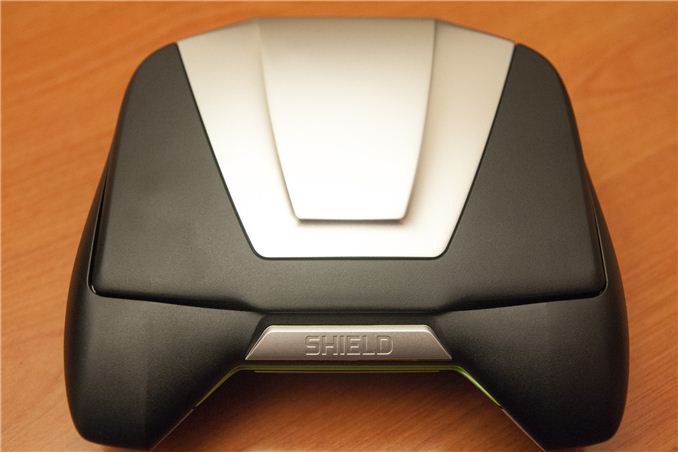
It seems like forever since CES 2013 when we first laid eyes on and played with NVIDIA’s Project Shield. Time flies, and since then Shield has dropped the Project and become just NVIDIA Shield. It’s not every day that we get to see a product go from being an early prototype with its own set of issues to final hardware ready to go into manufacturing in large numbers, but with Shield we’ve been given that very opportunity. Both Anand and myself got a chance to take a look at NVIDIA’s final Shield hardware.
Shield is of course NVIDIA’s reference Tegra 4 tablet turned part gaming controller slash PC streamer, part handheld gaming console running Android. Inside is of course the Tegra 4 SoC with four ARM Cortex A15s running at up to 1.9 GHz and 72 core GPU built on TSMC’s 28nm HPL process. It’s topped by a 5-inch 720p 294 PPI display and comes with 16 GB of internal storage, 2 GB of DDR3L, 2x2:2 802.11n dual band WiFi, and a microSD card slot. Atop all of that runs Android 4.2.1, but 4.2.2 is coming. Again Shield will always basically be running the latest stable version of the NVIDIA Tegra 4 BSP (Board Support Package) software, and updates come from NVIDIA. The specs really don’t tell the whole story though – and they haven’t changed – the key is in the subjective feel and ergonomics of Shield as a controller and its ability to be a standalone gaming console.
To say that Shield has come a long way is to put it lightly. The early hardware was very prototype-y, with a D-Pad that was mushy, triggers that didn’t feel right, analog sticks that weren’t tuned yet, and buttons that didn’t feel communicative enough. Even at Google I/O, NVIDIA was showing off Shield with hardware that wasn’t quite final yet, with a mushy D-Pad and analog sticks that still didn’t feel quite right to me.
The final Shield is much, much better.
NVIDIA’s tuning to the Shield hardware focused on pretty much all the points we touched on as concerns regarding the controller. I find myself drawing comparisons between Shield and the Xbox 360 controller since it reflects my almost-ideal controller. On the final Shield hardware the analog sticks have nubs on them and have a good amount of resistance, and are textured nicely.
The all-important D-Pad is much more communicative and clicky. I’m not much of a platform player however so I’m not sure if it will appease everyone, I’m also not sure if this is a hat switch or not, but I had no problem knowing whether I was pushing up down left or right. The triggers on the back likewise have much better resistance, and both bumpers have great crisp breaks. The remainder of the buttons likewise are clicky and responsive.
Talking about a controller for me isn’t so much finding things that are well done as things that fade into the experience and can be taken for granted, and in my hour or so with Shield I can’t think of anything that would frustrate me. That said it’s hard to really know where a controller or interface is going to fatigue you until you’ve used it for a few hours.
That brings me to the weight and mass question. NVIDIA moved around the batteries inside Shield, but the overall balance still feels good. What’s really different to me about Shield versus holding any of the other controllers (PS3, Xbox 360 Wired or Wireless) is how I can rest the whole console in basically both palms. The topology of the underside essentially rests on a shelf formed by your fingers. It’s hard to describe, but I’m reminded of my favorite Xbox 360 controller by Scuff gaming with the underside buttons which make you put your hands that way.
The final Shield hardware also has a significantly beefier display hinge, which makes the whole thing feel more snug and solid. There’s also that new metal Shield logo at the bottom between the front air intake (yes, Shield’s Tegra 4 remains actively cooled with a fan that kicks in after it crosses a certain temperature). If I could describe the final Shield hardware it honestly would follow that language – tougher and beefier and less delicate.
The buttons now navigate through Android much more effectively as well. Left and right bumper take you through pages in the launcher, reminiscent of the navigation on the Xbox 360. The left analog stick works like a virtual mouse and pops up a cursor, the D-Pad accordingly works like you’d expect. I found myself using those controls more than the touchscreen, though there are inevitably actions (both in games in Android) which require you take a hand off of balancing Shield and interact with the display.
I still however find myself wishing that the LCD display was bigger. Not because 5-inches diagonal is too small, or 720p too low res, but because the large black bezel around the thing makes it still look a rather awkward. I’m surprised NVIDIA couldn’t cut a deal with LG for some of their bigger 1080p panels (like the one from the Optimus G Pro) but I suspect there’s no easy way to get something better without compromising price point. The form factor of Shield also necessitates a landscape layout, and landscape layouts have been something of a rarity in Android since the departure of handsets with QWERTY hardware keyboards. There’s more than a few apps which only work in portrait or have some view which works only in portrait, but hopefully NVIDIA and Shield both will persuade some of this to change back.
The remainder of the equation for Shield’s viability as a console remains a software one, and here NVIDIA has to rely on the Android platform’s ability to deliver games customers want. Shield is effectively a gaming console running Android, something everyone talks about but nobody has really executed or delivered on entirely (sorry Ouya) – at least yet. Shield will ship with a few gaming related preloads, Sonic 4 Episode II THD and Expendable: Rearmed for games, plus Twitch TV and Hulu+ apps optimized for Shield. Of course there’s Google Plus and NVIDIA TegraZone as well. Beyond that though NVIDIA is relying on Android developers to make games which work and play well on Shield’s rather unique form factor. At launch, NVIDIA claims it will have 30 optimized titles available which work well with the controller and are optimized for landscape displays. Of course any game on Google Play with controller support will work on Shield.
The PC streaming aspect remains a second way to use Shield, and it’s a big sell in for a beefy desktop GPU, even if Shield becomes little more than a video decode sink and controller. In this setup, your NVIDIA based PC actually handles all of the 3D rendering before encoding the frame buffer as a video stream and sending it over WiFi to Shield. Presently, this personal GPU cloud only works in a 1-to-1 (one desktop to one Shield) ratio and it's only designed for local use.
Latency is impressively low and there’s minimal to no hitching. I played Borderlands on Shield connected to a Falcon Northwest box with GeForce Titan inside and found it more than playable. The obvious end goal however is to use some GPUs virtualized in the cloud with GRID and stream games to Shield, but it’s not quite there yet.
I find myself wishing that NVIDIA could launch Shield as a Nexus Experience device of some kind as a flagship platform with the new Google Play gaming services APIs as the context, but I’m not sure that’s in the cards. NVIDIA is steadfast with its “late June 2013” ship date, price remains $349 for NVIDIA’s foray into handheld gaming with Tegra 4.



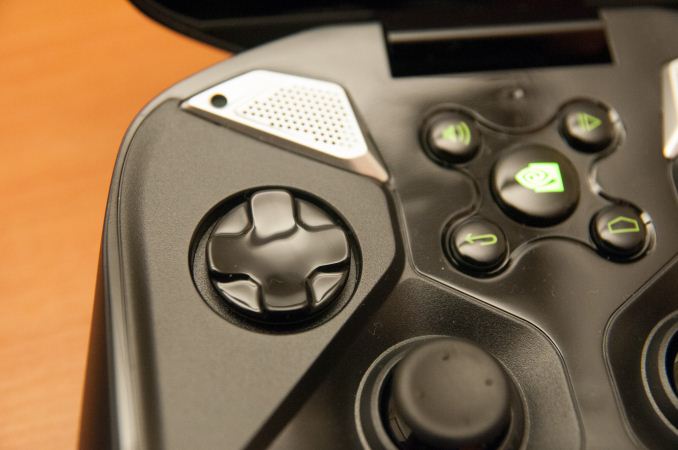
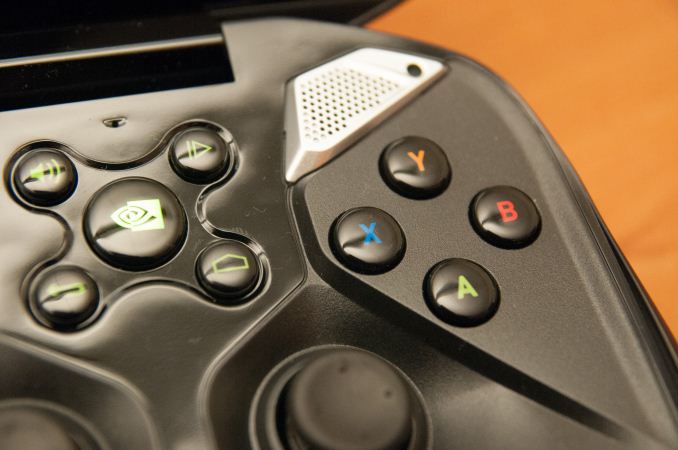
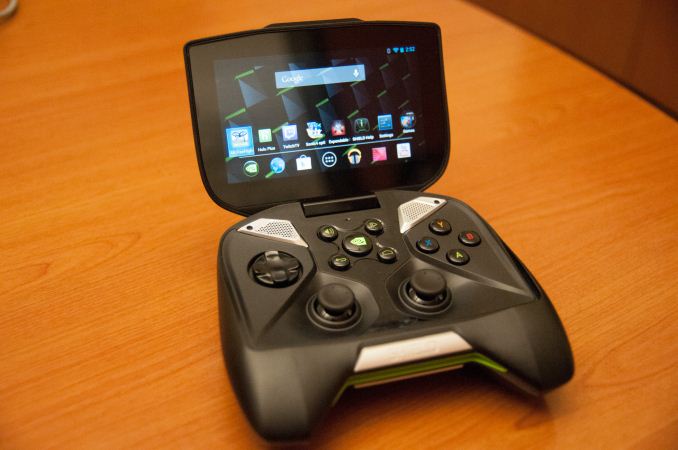
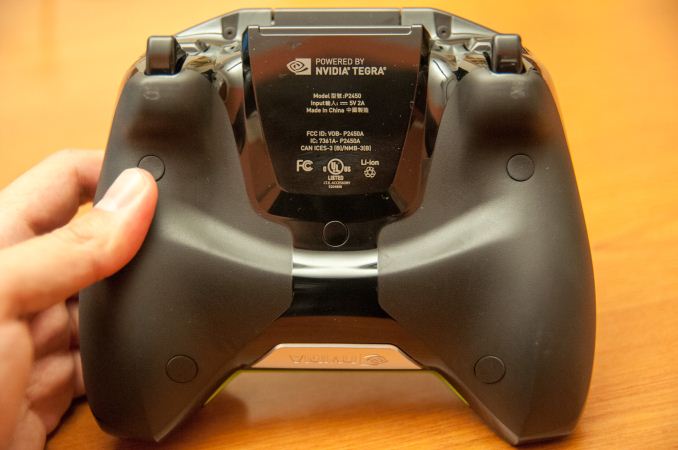














46 Comments
View All Comments
dwade123 - Tuesday, June 11, 2013 - link
Dead of arrival.Michael Ganesan - Monday, June 17, 2013 - link
That is what they said about the smart phone? Guess they pundits need an 8 ball!airspoon - Sunday, June 23, 2013 - link
The smartphone succeeded because Apple reinvented a user interface that was intuitive and breathtakingly innovative. In other words, innovation made them useful. NVIDIA hasn't reinvented anything, as gaming consoles weren't really lacking to begin with. As I sad in my above post, people enjoy Android games when they are waiting somewhere or bored with nothing else to do. NVIDIA is trying to reinvent the wheel, a design that already works best in its current form. This is certainly not enough to compete, price-wise, with the PS4. Android games are useful to adults because they already have a platform to play them. Likewise, android games are useful for small children because the user interface is intuitive, giving parents a tool to keep their children occupied with something. NVIDIA and other companies are reading the data wrong on Android/iOS game sales. While many people are buying and playing, they are doing so out of convenience.LordConrad - Tuesday, June 11, 2013 - link
Definitely DOA, it's to pricey. Shield has no place in this market. People will stick with their phones and tablets for portable gaming. For consoles, in order of price and performance: Ouya, Wii U, Xbox One and PS4.Joel Kleppinger - Tuesday, June 11, 2013 - link
Wait, what? Xbox One ahead of PS4? I don't get it... PS4 is both faster and $100 cheaperjelloboy - Wednesday, June 12, 2013 - link
For $100 you're getting a Kinect and that all-important HDMI input and the much better Xbox Live service, but regardless I don't think Amazon accepts foodstamps so I wouldn't worry about trying to get either if I was you.joos2000 - Thursday, June 13, 2013 - link
I don't see how the Kinect is a perk; to me it is more of a detriment I have to pay a premium for. Don't get me started on the convoluted DRM and erosion of ownership MS is trying to cram down our throats.And why is HDMI pass through important? Can't you afford a TV with more than one input? Maybe you should start saving those food-stamps yourself.
max1001 - Thursday, June 20, 2013 - link
HDMI pass through is important because you can integrate your cable service with the console.larsoncc - Thursday, June 20, 2013 - link
I would like for someone to explain, cause I don't get it - why would I want to integrate console with cable service? What would that give me that PIP/POP doesn't already give me? Xbox One won't control my DVR, so I can't pause the TV when someone is interrupting me on Skype... Doesn't eliminate remotes, or slow tuner response, or anything, and it adds an interrupting force -- "I wanna watch TV right now, despite the fact that you're clearly engaged in gaming". It's basically an excuse for MS to gather data on my TV viewing habits with "benefits" no one will clearly explain.aicom - Tuesday, June 11, 2013 - link
I don't see it that way.In fact, I'd say Shield is my ideal around-the-house Android device. If I want to watch a movie or something on my Galaxy Nexus or Nexus 7, I have to sit there and hold it up. When I eventually get tired of doing that, I end up having to find a place to prop it up just right so I can still see it and it doesn't fall over. The Shield has none of these problems. I can comfortably sit it down somewhere and not worry about it falling over (or having to use a special case to prop it up).
It's definitely heavier than an Android smartphone, but who cares? I have a smartphone for when I want a phone. Gaming/Streaming on the Shield is just icing on the cake for me.